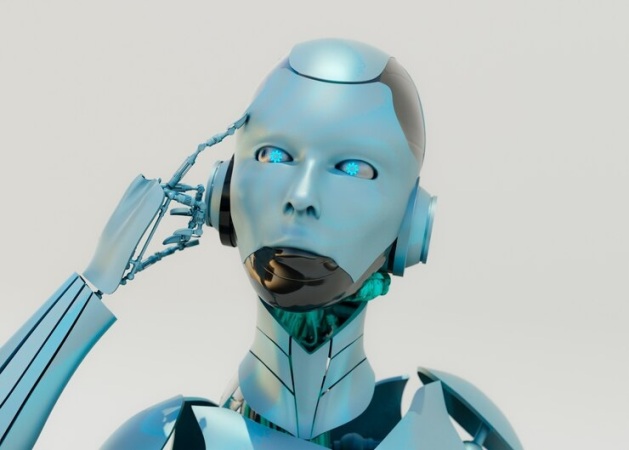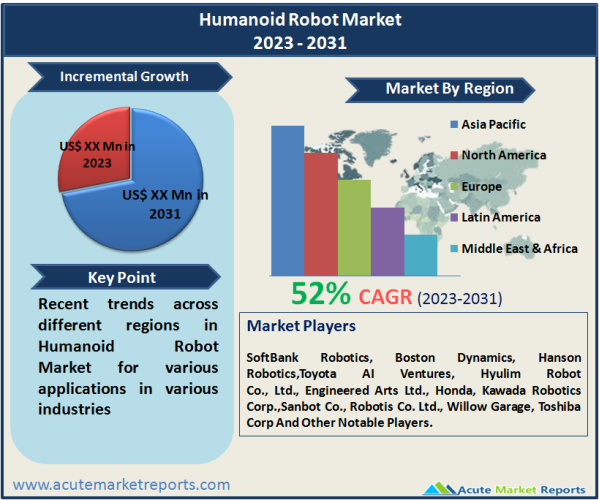
The humanoid robot market is expected to grow at a CAGR of 52% during the forecast period of 2025 to 2033. The humanoid robot market represents a cutting-edge segment of robotics, bringing machines closer to emulating human movements and functions. The humanoid robot market is poised for substantial growth, driven by advancements in AI, growing demand in healthcare, and improvements in sensor technology. While cost remains a restraint, efforts to enhance affordability and accessibility are essential. The segmentation data for product types and components, along with geographic trends, provide valuable insights for stakeholders, enabling them to navigate this dynamic market and contribute to the integration of humanoid robots into various industries in an evolving technological landscape.

Advancements in Artificial Intelligence (AI) and Machine Learning (ML)
One of the primary drivers propelling the humanoid robot market is the continuous advancements in AI and ML technologies. These innovations empower humanoid robots with the ability to perceive their environment, learn from it, and adapt their actions accordingly. With sophisticated algorithms and deep learning, these robots can perform tasks that were previously reserved for humans, such as recognizing objects, understanding natural language, and making complex decisions. There is rapid progress in AI and ML research and its application to robotics. Numerous breakthroughs in computer vision, natural language processing, and reinforcement learning have been achieved, enabling humanoid robots to interact with humans more effectively. The demand for AI-powered humanoid robots in various industries, from healthcare to manufacturing, is a testament to the growing influence of these technologies.
Growing Demand for Robotics in Healthcare
The second major driver is the growing demand for humanoid robots in the healthcare sector. These robots are increasingly employed in patient care, assisting healthcare professionals in tasks such as patient monitoring, medication management, and rehabilitation exercises. With an aging global population and the need for personalized healthcare services, humanoid robots are well-suited to address these challenges. There has been a steady adoption of humanoid robots by healthcare facilities worldwide. Studies and reports highlight the positive impact of robots in improving patient outcomes, reducing healthcare costs, and enhancing the quality of care. As healthcare providers continue to recognize the value of humanoid robots, the market is expected to witness significant growth.
Advancements in Sensor Technology and Actuators
The third significant driver is the continuous advancements in sensor technology and actuators. These components are essential for enabling humanoid robots to perceive their surroundings and execute precise movements. Sensors such as LiDAR, cameras, and tactile sensors provide robots with real-time data about their environment, allowing them to navigate complex spaces and interact with objects and humans. There has been significant development and adoption of advanced sensors and actuators in the field of robotics. Research and engineering efforts have led to the miniaturization and cost reduction of these components, making them more accessible for humanoid robot manufacturers. As sensor technology and actuators continue to improve, humanoid robots become more capable and versatile, driving market growth.
High Costs of Development and Production
Despite the promising growth of the humanoid robot market, a significant restraint is the high costs associated with the development and production of these complex machines. Designing and manufacturing humanoid robots with human-like capabilities require substantial investments in research, development, and specialized components. As a result, the final products often come with a hefty price tag. While demand for these robots is increasing, affordability remains a challenge for many potential buyers. Manufacturers and developers need to address cost barriers to make humanoid robots more accessible to a wider range of industries and applications.
Market Segmentation by Product Type: Biped Category Dominates the Market
The humanoid robot market is segmented by Product Type into Biped and Wheel Drive. In 2024, the Biped category generated the highest revenue, driven by its ability to closely mimic human locomotion and perform tasks in diverse environments. However, during the forecast period from 2025 to 2033, the Wheel Drive segment is expected to exhibit the highest Compound Annual Growth Rate (CAGR). This shift is attributed to the versatility and stability offered by robots with wheel-based locomotion, making them suitable for applications in logistics, manufacturing, and service sectors.
Market Segmentation by Component: Hardware Segment Dominates the Market
The market is further segmented by Component into Hardware and Software. In 2024, the Hardware category accounted for the highest revenue, reflecting the significance of robust mechanical systems and sensors in humanoid robots. However, during the forecast period from 2025 to 2033, the Software segment is expected to experience the highest CAGR. This growth is driven by the increasing importance of software algorithms, AI, and ML in enhancing the capabilities of humanoid robots.
APAC remains as the Global Leader
Geographic trends in the humanoid robot market indicate that Asia-Pacific had the highest revenue percentage in 2024, driven by a strong presence of robotics manufacturers, particularly in countries like Japan and South Korea. However, during the forecast period from 2025 to 2033, North America is expected to exhibit the highest CAGR. This growth is attributed to the expanding adoption of humanoid robots in healthcare, research, and logistics sectors in the region.
Market Competition to Intensify during the Forecast Period
In 2024, the top players in the humanoid robot market included companies such as SoftBank Robotics, Boston Dynamics, Hanson Robotics,Toyota AI Ventures, Hyulim Robot Co., Ltd., Engineered Arts Ltd., Honda, Kawada Robotics Corp.,Sanbot Co., Robotis Co. Ltd., Willow Garage and Toshiba Corp., among others. These organizations leveraged their expertise in robotics, AI, and sensor technology to develop advanced humanoid robots with diverse applications. During the forecast period from 2025 to 2033, these key players are expected to maintain their leadership positions by focusing on product innovation, expanding their market presence, and forming strategic partnerships. Collaborations with research institutions and industry stakeholders are likely to drive advancements in humanoid robotics, ensuring the market's continued growth.
Historical & Forecast Period
This study report represents analysis of each segment from 2023 to 2033 considering 2024 as the base year. Compounded Annual Growth Rate (CAGR) for each of the respective segments estimated for the forecast period of 2025 to 2033.
The current report comprises of quantitative market estimations for each micro market for every geographical region and qualitative market analysis such as micro and macro environment analysis, market trends, competitive intelligence, segment analysis, porters five force model, top winning strategies, top investment markets, emerging trends and technological analysis, case studies, strategic conclusions and recommendations and other key market insights.
Research Methodology
The complete research study was conducted in three phases, namely: secondary research, primary research, and expert panel review. key data point that enables the estimation of Humanoid Robot market are as follows:
Market forecast was performed through proprietary software that analyzes various qualitative and quantitative factors. Growth rate and CAGR were estimated through intensive secondary and primary research. Data triangulation across various data points provides accuracy across various analyzed market segments in the report. Application of both top down and bottom-up approach for validation of market estimation assures logical, methodical and mathematical consistency of the quantitative data.
| ATTRIBUTE | DETAILS |
|---|---|
| Research Period | 2023-2033 |
| Base Year | 2024 |
| Forecast Period | 2025-2033 |
| Historical Year | 2023 |
| Unit | USD Million |
| Segmentation | |
Motion Type
| |
Component
| |
Application
| |
|
Region Segment (2023-2033; US$ Million)
|
Key questions answered in this report